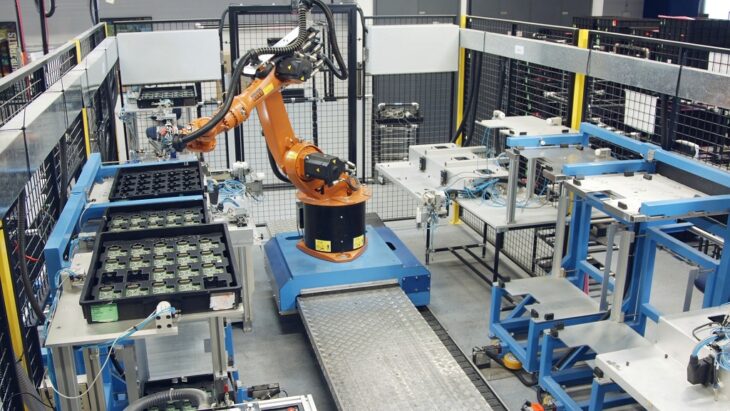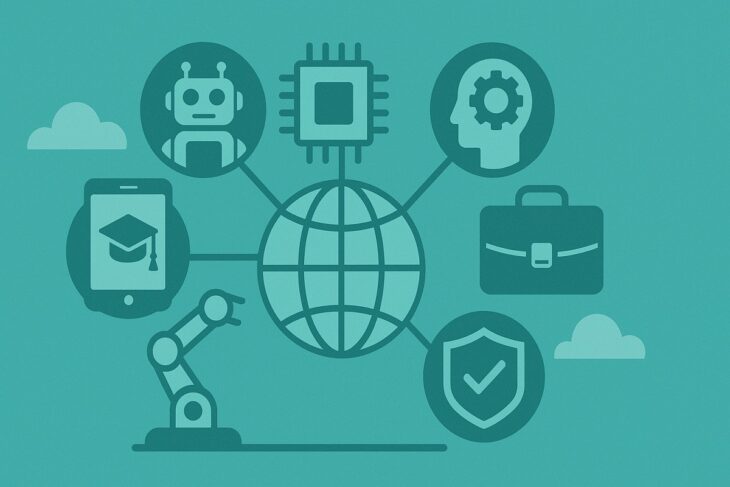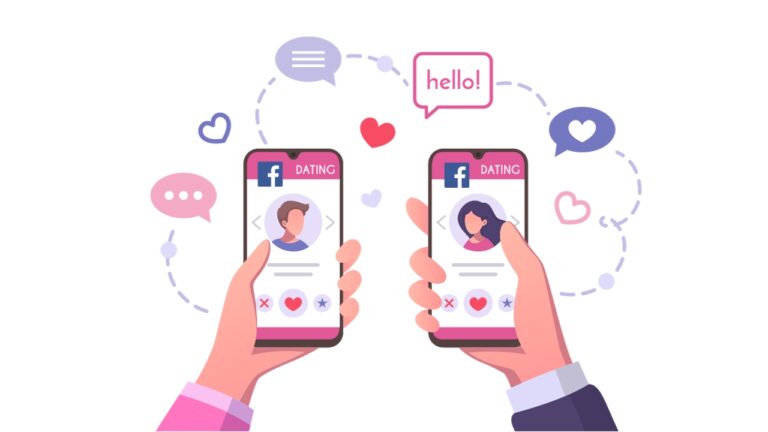The most important technology trends of 2025 are not just abstract concepts but forces already reshaping the global labor market. Artificial intelligence, automation, green energy, biotechnology, cybersecurity, and immersive digital tools are no longer niche – they are driving new job categories, transforming existing roles, and redefining how careers will develop in the next decade.
According to the World Economic Forum’s 2025 Future of Jobs report, nearly 23% of global jobs are expected to change by 2030, with millions disappearing but tens of millions emerging in fields tied to these trends.
For professionals, this means that adaptability, continuous learning, and cross-disciplinary skills are no longer optional but essential for career survival.
Table of Contents
Toggle1. Artificial Intelligence and Generative Models

AI has shifted from supportive automation to full-fledged decision-making and creative work. Generative AI is now integrated into law, healthcare diagnostics, content creation, and design.
In 2025, 70% of companies globally are using some form of AI in core processes, and AI literacy is increasingly considered as fundamental as Excel proficiency once was.
| AI Impact Area | Change in 2025 | Career Implications |
| Healthcare | AI diagnostics reduce errors by ~30% | More demand for AI-assisted medical analysts |
| Law & Compliance | 40% of document review is automated | Need for hybrid lawyer-technologists |
| Marketing & Media | Generative AI produces 60% of ad drafts | Creative directors shift toward strategy |
2. Green Tech and Renewable Energy

Sustainability is not just a policy; it is a massive job creator. Solar, wind, hydrogen, and carbon-capture technology are booming industries in 2025.
Governments and corporations are investing heavily, leading to demand for technicians, project managers, and engineers.
| Renewable Source | Global Capacity Growth (2025) | Related Careers |
| Solar PV | +22% YoY | Solar installers, energy system designers |
| Wind | +14% YoY | Offshore wind engineers, maintenance crews |
| Hydrogen | +18% YoY | Hydrogen fuel researchers, logistics managers |
3. Cybersecurity Everywhere
With the rise of AI-driven attacks, ransomware, and deepfakes, cybersecurity has become central to both business continuity and national security.
Careers in ethical hacking, cyber forensics, and AI-based defense systems are in urgent demand.
- Stat: Cybercrime damages are projected to hit $10.5 trillion annually by 2025.
- Job growth: Cybersecurity employment is expected to grow by 32% between 2024 and 2030 (U.S. Bureau of Labor Statistics).
4. Quantum Computing Comes Closer
Quantum computing is no longer science fiction. IBM, Google, and startups are moving toward practical commercial use, especially in pharmaceuticals and financial modeling.
While mass adoption is a decade away, 2025 marks the year companies start hiring quantum engineers and hybrid physicist-programmers.
| Quantum Use Case | Example in 2025 | Career Path |
| Pharma | Molecule simulations for drug design | Quantum chemists |
| Finance | Faster risk modeling | Quantum data scientists |
| Logistics | Route optimization | Applied mathematicians |
5. Robotics and Automation in Daily Work

Robotics is expanding beyond warehouses and factories into logistics, hospitality, and healthcare. Autonomous delivery drones, robotic exoskeletons for workers, and hospital-assisting robots are creating entirely new maintenance and supervisory roles.
- Fact: By 2025, 40% of warehouses in the U.S. will use collaborative robots (cobots).
- Career note: Technicians trained in both robotics and IT integration are among the fastest-growing professions.
6. Extended Reality (XR) – AR, VR, and Mixed Reality
The metaverse hype has cooled, but practical XR has flourished. In 2025, AR glasses will be used in classrooms, VR simulations in corporate training, and mixed reality in design studios.
This trend is revolutionizing fields from architecture to mental health therapy.
- Example: Surgeons now train with VR simulations that reduce real-world mistakes by 29%.
- Careers: XR content designers, VR therapy specialists, and AR field technicians.
7. Biotechnology and Human Enhancement

CRISPR gene editing has entered its third major generation, improving accuracy so significantly that genetic conditions once thought untreatable are beginning to see real solutions.
Personalized medicine, powered by AI and big data, is making “one-size-fits-all” treatments a thing of the past, while biofabrication, using 3D printing to create tissue and even early organ models, is transforming both research labs and clinical testing.
Beyond healthcare, biotech innovations are also influencing material science, where bioengineered compounds are replacing traditional plastics and metals in some industries.
Biomedical engineers are developing lab-grown tissues that pharmaceutical companies use to safely test new drugs. Analysts fluent in bioinformatics and machine learning are driving the adoption of AI-assisted treatment planning.
For anyone entering the job market, biotech in 2025 is one of the most promising fields – offering not just high growth but also meaningful, impactful work.
| Biotech Sector | 2025 Breakthrough | Career Opportunities |
| Gene Editing | CRISPR 3.0 reduces error rates by 95% | Genetic counselors, lab researchers |
| Biofabrication | 3D-printed tissues for drug testing | Biomedical engineers, biomanufacturing techs |
| Personalized Med | AI-driven treatment plans tailored to DNA | Data-biomedicine analysts, bioinformaticians |
8. Smart Infrastructure and 5G/6G Networks
Smart traffic systems powered by AI reduce congestion, improve emergency response times, and cut emissions by fine-tuning traffic lights and flow in real time. Sensor-based energy grids are now standard in many metropolitan areas, allowing utilities to predict usage and balance renewable energy inputs more effectively.
With the rollout of early 6G trials, the data capacity of urban environments is exploding, supporting everything from driverless vehicle fleets to predictive maintenance in public transit systems.
Civil engineers are learning IoT systems and analytics, moving from purely physical construction into “digital twin” simulations of infrastructure. IoT engineers and network specialists are crucial in maintaining and expanding these systems.
The result is that a career in infrastructure today is not just about pouring concrete but about building intelligent systems that keep cities sustainable and livable.
- Fact: By 2025, 65% of urban areas in developed nations will use AI-driven traffic management to optimize flow and reduce emissions.
- Job growth: IoT engineering, smart grid management, and data-driven civil engineering jobs are among the fastest-growing areas in public-sector technology.
9. Space Economy Expansion
More companies than ever are launching satellites for internet coverage, weather tracking, and Earth imaging, while startups are experimenting with asteroid mining and orbital manufacturing. What was once a billion-dollar industry now has trillion-dollar potential, with forecasts projecting the space economy to reach $1.8 trillion by 2035.
This democratization means the range of careers connected to the space economy is widening. Aerospace engineers are needed to design spacecraft that can operate efficiently and withstand multiple launches. Logistics specialists are managing the complex supply chains that extend into orbit.
Even space law experts are becoming indispensable, creating frameworks for property rights, international collaboration, and dispute resolution in a domain that still lacks clear regulations.
10. Continuous Learning and Human-AI Collaboration
The final but perhaps most transformative trend of 2025 is the recognition that learning never stops. Careers are no longer linear journeys where one degree sets you up for life.
Instead, the expectation is that professionals will reskill or upskill multiple times in their working lives. AI is playing a central role in this shift, with personalized tutors that can adapt content to an individual’s learning style and pace.
Corporations are adopting microlearning programs, 10 to 15-minute daily lessons designed to keep skills sharp without overwhelming employees. Meanwhile, blockchain is bringing transparency to credentialing, making digital certifications portable across employers and borders.
For workers, this trend means security comes not from holding a single job title for decades, but from maintaining a constantly evolving portfolio of skills.
Someone starting as a software developer in 2025 may, within a decade, transition into AI ethics, product management, or data governance – with each move supported by targeted reskilling programs.
Employers are increasingly providing learning stipends, subscriptions to training platforms, and partnerships with online universities.
| Learning Trend | What It Looks Like in 2025 | Career Effect |
| AI Tutors | Personalized corporate training | Faster reskilling cycles, reduced turnover |
| Microlearning | 10-15 min daily interactive modules | Learning fits into busy schedules |
| Credentialing | Blockchain-based certificates | Portable, verified, and transparent skills |
Conclusion
The technology landscape of 2025 is not defined by one invention but by the convergence of multiple forces. AI, biotech, robotics, and renewable energy are simultaneously reshaping industries.
The careers of the future are hybrid, requiring professionals to mix technical expertise with creativity, adaptability, and lifelong learning.
For students choosing majors and workers considering reskilling, the clear opportunities lie in AI fluency, green energy, cybersecurity, biotech, and applied engineering jobs tied to infrastructure and robotics.



